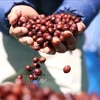Farmers enjoy unsatisfactory benefits from high rice prices, says a report recently launched by the Institute of Policy and Strategy for Agriculture and Rural Development (IPSARD) and Oxfam.
According to the report, entitled “Who has benefited from high rice prices in Vietnam ?”, falling world rice prices will pull farmers’ selling prices down, however, when the world rice prices go up, farmers gain little from it.
Tran Cong Thang, an expert from IPSARD and one of the co-authors of the report, said that benefits in the rice value chain are distributed unfairly. Rice farmers in the Mekong Delta province of An Giang received only 30 percent of the profit in the value chain even though they bear 60 to 70 percent of the total production costs.
The remainder of profits is split between exporters and intermediaries in the Mekong Delta, where their role of intermediaries does not go unnoticed, he added.
World Bank and Oxfam studies in 2012 indicated that the average income of rice growing households in the Mekong Delta, the region with the best rice growing conditions, was merely 535,000 VND (some 24.5 USD) per person per month, which is about half the minimum living wage.
Therefore, farmer households with less than 2ha of land do not live on only rice growing but on other incomes from husbandry, aquaculture or non-agricultural business.
The Oxfam report analyses fluctuations of food prices and other related issues such as food security and poverty, especially for small-scale producers and vulnerable women. It also points out that rice export policies benefit exporters as the policy making process does not involve farmers.
The report puts forth seven recommendations, including strengthening the voice of farmers through associations and ensure they are heard in trade regulation and policy making processes; improving direct linkages between rice growers, exporters and importing countries; and developing a strategy to improve the quality and brand of Vietnamese rice to increase demand and higher added value.
It suggests forming commercial rice production areas with the participation of farmers, developing high-quality and climate resistant rice varieties, building rice warehouses to help maintain rice quality after harvesting, and setting a start-of-season floor price that takes into account all production costs and regional variations.
To develop a sustainable, effective and equal rice production industry for Vietnam, polices should be changed to increase benefits for small-scale farmers, said Andy Baker, Oxfam Chief Representative in Vietnam.
Policies on rice growing and export need to focus on farmers who directly produce rice, he added.
According to Dr. Dang Kim Son, IPSARD Director, rice production is an important advantage of Vietnamese agriculture and also a livelihood for most local households. However, in the rice value chain, farmers gain much less than other stakeholders.
The report is part of Oxfam’s global campaign named “GROW” to look towards a future where everyone on the planet always has enough to eat.-VNA
According to the report, entitled “Who has benefited from high rice prices in Vietnam ?”, falling world rice prices will pull farmers’ selling prices down, however, when the world rice prices go up, farmers gain little from it.
Tran Cong Thang, an expert from IPSARD and one of the co-authors of the report, said that benefits in the rice value chain are distributed unfairly. Rice farmers in the Mekong Delta province of An Giang received only 30 percent of the profit in the value chain even though they bear 60 to 70 percent of the total production costs.
The remainder of profits is split between exporters and intermediaries in the Mekong Delta, where their role of intermediaries does not go unnoticed, he added.
World Bank and Oxfam studies in 2012 indicated that the average income of rice growing households in the Mekong Delta, the region with the best rice growing conditions, was merely 535,000 VND (some 24.5 USD) per person per month, which is about half the minimum living wage.
Therefore, farmer households with less than 2ha of land do not live on only rice growing but on other incomes from husbandry, aquaculture or non-agricultural business.
The Oxfam report analyses fluctuations of food prices and other related issues such as food security and poverty, especially for small-scale producers and vulnerable women. It also points out that rice export policies benefit exporters as the policy making process does not involve farmers.
The report puts forth seven recommendations, including strengthening the voice of farmers through associations and ensure they are heard in trade regulation and policy making processes; improving direct linkages between rice growers, exporters and importing countries; and developing a strategy to improve the quality and brand of Vietnamese rice to increase demand and higher added value.
It suggests forming commercial rice production areas with the participation of farmers, developing high-quality and climate resistant rice varieties, building rice warehouses to help maintain rice quality after harvesting, and setting a start-of-season floor price that takes into account all production costs and regional variations.
To develop a sustainable, effective and equal rice production industry for Vietnam, polices should be changed to increase benefits for small-scale farmers, said Andy Baker, Oxfam Chief Representative in Vietnam.
Policies on rice growing and export need to focus on farmers who directly produce rice, he added.
According to Dr. Dang Kim Son, IPSARD Director, rice production is an important advantage of Vietnamese agriculture and also a livelihood for most local households. However, in the rice value chain, farmers gain much less than other stakeholders.
The report is part of Oxfam’s global campaign named “GROW” to look towards a future where everyone on the planet always has enough to eat.-VNA



















